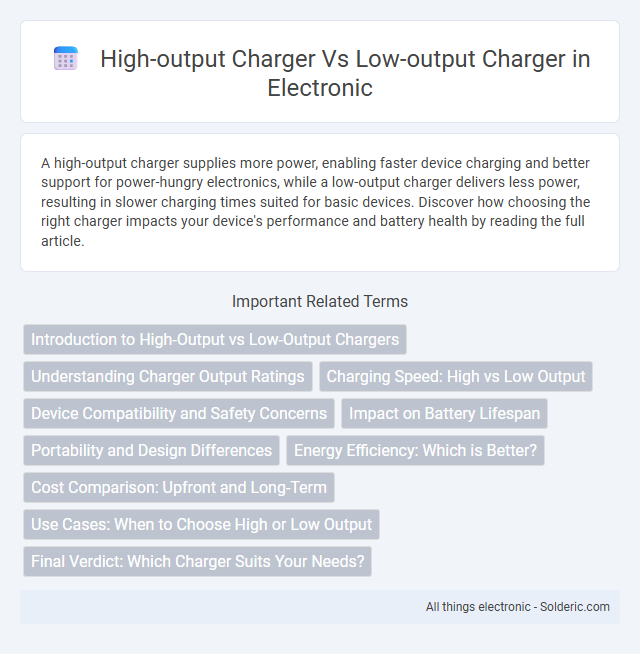A high-output charger supplies more power, enabling faster device charging and better support for power-hungry electronics, while a low-output charger delivers less power, resulting in slower charging times suited for basic devices. Discover how choosing the right charger impacts your device's performance and battery health by reading the full article.
Comparison Table
| Feature | High-Output Charger | Low-Output Charger |
|---|---|---|
| Power Output | 30W and above | Below 15W |
| Charging Speed | Fast charging, 50-70% battery in 30 minutes | Slow charging, full charge takes several hours |
| Use Case | Smartphones, tablets, laptops | Low-power devices, backup charging |
| Portability | Larger, heavier | Compact, lightweight |
| Price | Higher cost | Lower cost |
| Heat Generation | Higher heat, requires better cooling | Lower heat |
| Compatibility | Supports fast charge protocols (PD, QC) | Basic USB charging |
Introduction to High-Output vs Low-Output Chargers
High-output chargers deliver significantly higher power levels, enabling faster charging times for devices such as smartphones, tablets, and laptops, often exceeding 30 watts. Low-output chargers typically provide 5 to 10 watts, suitable for basic phones or slower charging needs but may result in longer charge durations. Your choice between high-output and low-output chargers depends on your device's power requirements and how quickly you need it charged.
Understanding Charger Output Ratings
Charger output ratings, measured in watts (W), volts (V), and amps (A), determine how quickly a charger can supply power to a device; high-output chargers provide greater wattage, enabling faster charging for compatible equipment. Low-output chargers, often limited to 5W or 10W, deliver slower charging speeds and are typically used for smaller devices or basic charging needs. Understanding these ratings helps consumers select chargers that match device requirements and ensures optimal charging efficiency.
Charging Speed: High vs Low Output
High-output chargers deliver significantly faster charging speeds by supplying higher wattage, often exceeding 30 watts, which rapidly replenishes your device battery compared to low-output chargers that typically provide 5 to 10 watts and require longer charging times. Devices optimized for fast charging protocols such as USB Power Delivery or Qualcomm Quick Charge benefit most from high-output chargers, minimizing downtime and enhancing convenience. Choosing a high-output charger can dramatically improve your charging efficiency, especially for smartphones, tablets, and laptops that support rapid charging standards.
Device Compatibility and Safety Concerns
High-output chargers deliver increased wattage, ensuring compatibility with power-hungry devices like laptops and tablets, while low-output chargers are best suited for smartphones and smaller gadgets. Using a high-output charger with low-power devices can lead to overheating, reducing battery lifespan and posing safety risks. Ensure your device supports the charger's power specifications to maintain optimal performance and safety.
Impact on Battery Lifespan
High-output chargers deliver faster charging speeds but generate more heat, which can accelerate battery wear and reduce overall lifespan. Low-output chargers provide slower, gentler charging that mitigates heat buildup and helps preserve battery health over time. Choosing the right charger for your device balances charging efficiency with maintaining optimal battery longevity.
Portability and Design Differences
High-output chargers often feature larger, bulkier designs to accommodate advanced circuitry and heat dissipation, making them less portable compared to low-output chargers that prioritize compactness for easy travel. Low-output chargers typically have a minimalist design, enhancing their portability but limiting charging speed and power capacity. The design trade-offs between these chargers reflect the balance between maximizing power delivery and maintaining user-friendly portability.
Energy Efficiency: Which is Better?
High-output chargers generally offer better energy efficiency by delivering power more quickly, reducing the time devices remain connected and minimizing energy loss during charging. Low-output chargers tend to have longer charging cycles, which can lead to higher energy consumption and heat generation, decreasing overall efficiency. Choosing a high-output charger with smart charging technology further optimizes energy use by adjusting the power output based on the device's needs.
Cost Comparison: Upfront and Long-Term
High-output chargers generally have a higher upfront cost due to advanced technology and faster charging capabilities, while low-output chargers tend to be more affordable initially but may result in longer charging times and increased energy consumption over time. Your long-term expenses with high-output chargers can be lower due to improved efficiency, reduced charging duration, and potential savings on electricity bills. On the other hand, low-output chargers might incur higher operational costs because of prolonged usage and possibly more frequent replacements.
Use Cases: When to Choose High or Low Output
High-output chargers are ideal for quickly powering devices like smartphones, tablets, and laptops, especially during short charging sessions or when you have limited time. Low-output chargers work well for smaller gadgets such as wireless headphones, fitness trackers, or devices that do not require rapid charging and benefit from steady, slower power delivery. Choose a high-output charger when you need fast, efficient charging for power-hungry electronics, and opt for a low-output charger to protect battery health during overnight charging or for low-energy devices.
Final Verdict: Which Charger Suits Your Needs?
A high-output charger delivers faster charging speeds by providing greater wattage, making it ideal for devices with large batteries or when you need to charge quickly. Low-output chargers, offering lower wattage, suit basic devices or slow charging needs, prioritizing energy efficiency and device longevity. Assess your charging habits and device requirements to determine which charger best aligns with your lifestyle and ensures optimal performance.
high-output charger vs low-output charger Infographic

 solderic.com
solderic.com